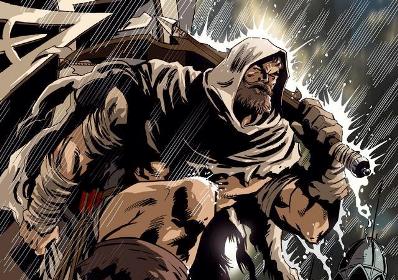| Switzerland
in the year 2032: Years of financial crises and civil war
have pushed the once flourishing country almost to the
brink of collapse as the gap between rich and poor has
widened to the point where the majority of people were
living in poverty and misery. Violence is the order of
the day, and politics are dominated by corruption and
self-interest as society at large is manipulated by a
single remaining political party in what used to be the
cradle of democracy. There seems to be no hope, no
perspective, until a towering figure makes his appearance
in a dark and gloomy city of Zurich who not only takes
out criminals and crooks but also seems to bear an
uncanny resemblance to the Swiss national hero - Tell.
His fleeting but effective appearances seem to suggest
that he is a vigilante on the side of the common people,
here to restore law and order with his crossbow - just as
the legendary Tell did in the 14th century when he
rid his people of a foreign tyrant and led them to
freedom and prosperity.
People
soon look up to the mysterious figure who seems to be
offering the long awaited salvation from all the misery,
and patriotism awakens again. At long last there is a
hero amongst them to fight for the their rights, the
rights of the people. But who is this Tell? And what are
his true intentions? Finn, a reporter, who was on the
scene of Tell's first appearance is intrigued and
investigates the matter further.
Finding
himself increasingly entangled in an obscure and menacing
web of politics, financial dealings and science without
ethics, the reporter is as confused as the general public
when history seemingly repeats itself and the newly risen
superhero Tell is confronted once again by Gessler - only
this time the tyrant is clad in a costume and seems to
have powers just as unworldly as those of the new Tell.
It is then that our reporter learns that there is a lot
more to this Tell than meets the eye...
|
| Tell -
The Legend Returns was released in print towards the
end of October 2010 as the first volume in a planned
series of three and is the work of comic book creator
David Boller. Born in 1968 in Zurich, Switzerland, he
started his own comics fanzine whilst still at school and
pursued his interests further by working as a freelancer
for several advertising agencies. After self-publishing a
series of comic books in Europe and founding his own
comic magazine in 1988, Boller moved to the States in
1992 where he enrolled at the Joe Kubert School of
Graphics and Cartoon Art in Dover, New Jersey. Following his
graduation in 1994 Boller worked for Marvel (Excalibur
Annual, Lethal Foes of Spider-Man, Night
Thrasher, Nova, Spider-Man 2099, X-Men:
Time Gliders, several promotional mini-comics) and
DC (Batman Chronicles, JLA 80-Page Giant)
as well as several other publishers such as Acclaim (Killer
Instinct Special, Magic The Gathering, Magnus
Robot Fighter), Caliber (Legendlore, Oz,
Raven Chronicles), Image (Witchblade)
and Warp (Elfquest-Jink). Boller also created
his own comic book series (Kaos Moon) in 1996,
which was published by Caliber in the US, serialized in
Germany in Schwermetall and featured in a series
of graphic novels by Alpha Comics.
Upon his
return to Switzerland in 2008, Boller founded his company
Virtual Graphics and kicked off his project Zampano, a web-comic
magazine platform. It is here that Boller first released
his story featuring the first Swiss comic book superhero
- Tell. Originally published online in weekly
installments in German, French and English, the first
issue of Tell was made available in a German
printed edition in Graphic Novel format in late October
2010.
|
